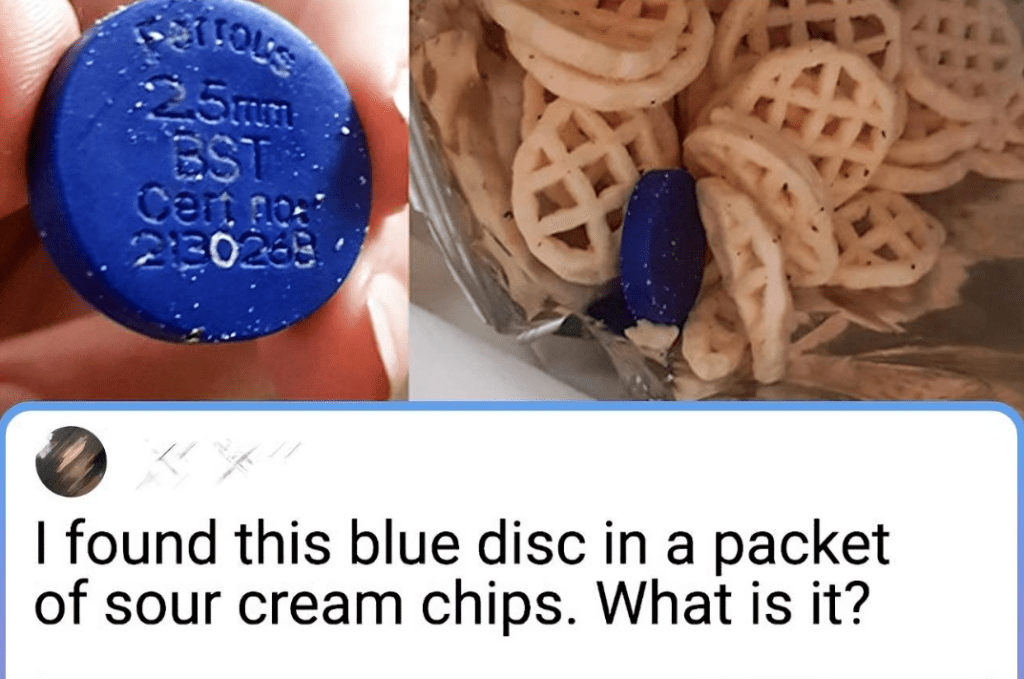Have you ever opened a bag of chips, expecting only crispy, flavorful bites, but instead, you found a mysterious blue disc hidden among them? If so, you’re not alone. Many people have stumbled upon this puzzling object, often embossed with text such as “Ferrous 25mm BST, Cert No. 213026B.” But what does it mean? And more importantly, how did it end up in your snack?
What Is the Blue Disc Found in a Packet of Chips?

At first glance, you might think it’s a promotional token, a production defect, or even an unexpected prize. However, this small blue disc is actually a metal detector test chip used in food processing plants.
This test chip is designed to ensure that food safety equipment—specifically, metal detectors—are working correctly. These chips are strategically placed on the production line to verify whether the detectors can identify and remove potential foreign objects. The blue color helps it stand out from the food, making it easier to spot if something goes wrong.
Why Are Metal Detector Test Chips Used in Food Manufacturing?
Food safety is a top priority for manufacturers. The presence of any foreign object, whether metal, plastic, or glass, poses a significant risk to consumers. To prevent contamination, most factories use metal detectors to scan food items before they are packaged and shipped.
Here’s how the process works:
- Test chips—like the one you found—are deliberately inserted into the production line at set intervals.
- Metal detectors scan the products, ensuring they catch the test chips.
- If the machine detects the chip, it triggers an alert and removes the contaminated item.
- If the chip is NOT detected, it signals a potential failure in the system, and production is halted until the issue is resolved.
Why Did the Test Chip End Up in My Chips?
Now, here’s where things get concerning. The very reason test chips exist is to prevent foreign objects from getting through. So if you found one in your bag of chips, it means something seriously went wrong in the quality control process.
There are a few possible explanations:
- The chip was misplaced and never retrieved – This suggests a human error where someone forgot to remove the test chip after conducting quality control.
- The metal detector failed – This is the most alarming possibility. If the detector failed to catch the test chip, it may have also missed other harmful objects, such as metal fragments or contaminants.
- Production oversight – Sometimes, manufacturing processes get rushed, and crucial safety checks are overlooked.
Regardless of the reason, this is a major red flag that warrants immediate action.
What Should You Do If You Find a Metal Detector Test Chip in Your Food?
If you ever find a test chip inside a food product, take the following steps:
- Do NOT consume any more of the product – There could be other contaminants present that went undetected.
- Keep the packaging and the chip – This will be crucial when reporting the issue.
- Contact the manufacturer immediately – Most brands have customer service lines or emails where you can report quality concerns.
- Request an explanation and possible recall information – If a test chip made it into your food, there’s a chance others might have had the same experience.
- Consider reporting the issue to a food safety authority – Agencies like the FDA (in the U.S.) or the FSA (in the UK) monitor food safety standards and may investigate further.
Will the Manufacturer Face Consequences?
Yes! Food safety protocols require companies to document every test chip used in their quality control process. When a test chip goes missing, production should stop immediately until it is found.
If you report the incident, the company will likely conduct an internal investigation to determine how this breach occurred. In some cases, it may even lead to:

- Product recalls – If multiple reports emerge, the company may be forced to recall entire batches of the affected product.
- Fines and penalties – Regulatory agencies may impose fines if they determine that safety protocols were neglected.
- Operational reviews – Manufacturers might overhaul their processes to prevent similar failures in the future.
Could There Be Other Foreign Objects in My Chips?
The unfortunate reality is that if a test chip made it through, other foreign objects could have as well. While food safety measures exist to minimize risks, errors do happen. There have been cases of consumers finding:
- Plastic or rubber fragments from conveyor belts
- Metal shavings from broken machinery
- Glass pieces from shattered equipment
- Insects or other biological contaminants
This is why quality control is so critical. The presence of a metal detector test chip in your chips raises serious questions about the reliability of the manufacturer’s safety measures.
Final Thoughts: Should You Be Concerned?
Absolutely. While finding a blue test chip in your chips might seem like a bizarre fluke, it’s actually a major food safety failure. These chips are meant to stay on the production line, not end up in your snack bag.
If this happens to you, take action. Report it, demand accountability, and spread awareness. Food safety should never be compromised, and manufacturers must be held to the highest standards to ensure that what we eat is truly safe.
The Gift of Fido

The silence in my small house had grown louder with each passing year. Old and alone, the days stretched out, often indistinguishable from one another. I thought about getting a dog, a creature that would fill the emptiness, a warm presence against the encroaching quiet.
One chilly afternoon, shuffling through the familiar streets, I saw him. A small, scruffy shape huddled near a bin, dirty and clearly hungry. He looked up as I approached, his eyes wide but without fear. I knelt down slowly, offering a tentative hand. He didn’t flinch. I stroked his matted fur, spoke softly to him. When I stood up to leave, he simply followed, a silent, trusting shadow.
Now, he is my dog. My Fido. I am his human, his owner, though it feels more like we own each other. The silence is gone, replaced by the soft pad of his paws, the occasional sigh, the happy thump of his tail against the floor.
I talk to him constantly, sharing my thoughts, my worries, the mundane details of my day. He answers in his own way – a tilt of the head, a soft whine, or his favorite response, a vigorous wash of my hand with his rough tongue.
“Fido,” I’d told him just the other day, the worry etching lines deeper into my face, “tomorrow we won’t have anything to eat. The retirement money is gone, finished. We’ll have to wait until pension day!” He just licked my hand, as if to say, “We’ll figure it out, together.”
And then that blessed day arrives. I join the queue, a line of fellow retirees, each clutching their worn pension book, shattered by time and use. My own is tight in my hands, a thin lifeline. Fido, tied patiently nearby, shakes himself happily, a little dance of anticipation. He knows this day. He knows that today the bowls will be fuller, the meal a little richer, a little better than the thin gruel of the days before.
Winter arrives, wrapping the house in its cold embrace. Without a fire, the air bites. But Fido is there. Curled tightly against my legs on the worn armchair, or tucked beside me in bed, his small body is a furnace, a constant, reliable source of warmth that chases away the chill. He is more than just a dog; he is my living, breathing blanket against the cold world.
The first hesitant rays of spring find us sitting outside, bathed in the gentle warmth of the returning sun. We sit in comfortable silence, simply existing, together, grateful for the light, for the warmth, for each other. And from deep within my heart, a simple prayer is born, a quiet whisper of profound gratitude: “Thank you, Lord, for creating the dog.” For creating Fido, who found me when I was alone, and filled my life with warmth, conversation, and unwavering companionship.



Leave a Reply